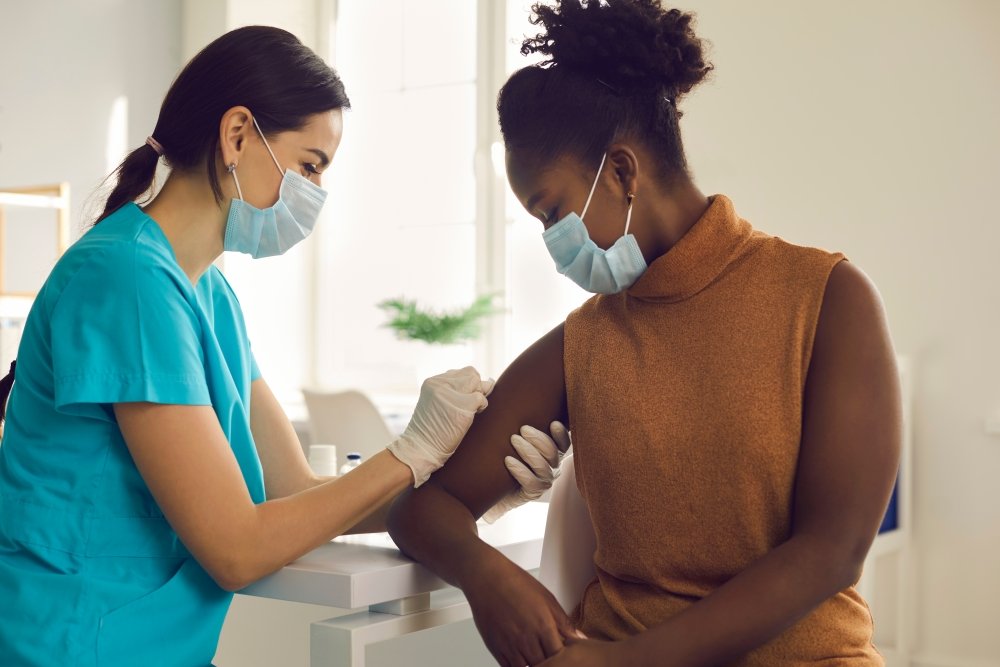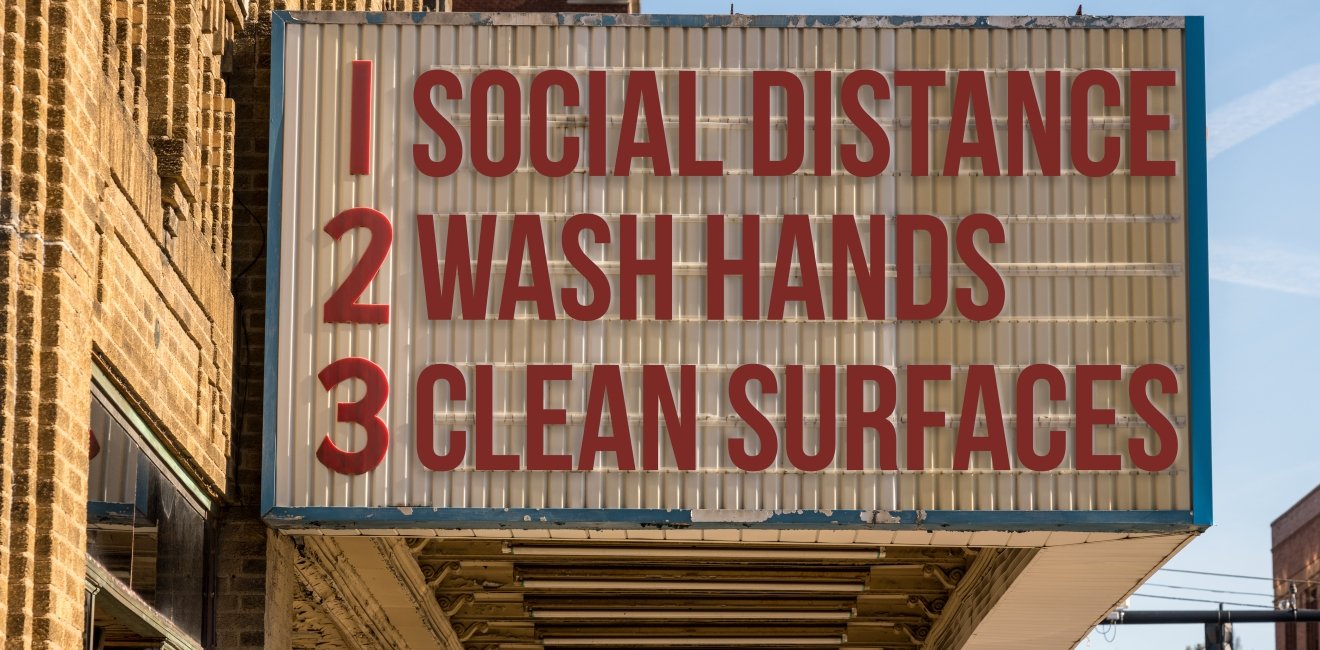
A blog of the Science and Technology Innovation Program
As U.S. cities and states continue to re-open, new COVID-19 cases decrease to their lowest number since last April, and friends’ faces are revealed after a year hidden behind masks, many Americans are hoping to put the virus behind them and move on from the pandemic.
However, the effort to contain COVID-19 is not yet over. Just over 40% of the population is fully vaccinated, and the number of daily vaccinations administered has steadily decreased over the last month despite all U.S. adults now becoming eligible to receive a vaccine (and anyone over the age of 12 now eligible to receive the Pfizer vaccine).
Still, relief may be coming to the wider public health community as a whole. Public health professionals – from Dr. Anthony Fauci to the CDC to your local medical practitioner – have worked since March 2020 to deliver to the public the most accurate and useful information around the virus, social distancing guidelines, and vaccines.
As life begins to return to something like a pre-pandemic normal, it is essential we continue to find ways to push the vaccination rate higher and begin to assess what public health professionals can learn from their work combatting the virus over the past 15 months.
With these objectives in mind, we spoke with Dr. Jeff Niederdeppe, Professor and Director of the Health Communication Research Initiative and Co-Director of the Cornell Center for Health Equity at Cornell University, to begin to pinpoint some key takeaways around the messaging used by public health professionals during the pandemic, discuss strategies to encouraging those who haven’t gotten vaccinated yet to do so, and evaluate the public’s long-term trust in U.S. public health institutions.
Q: In what ways do you think we have historically built-up anti-science sentiment in the general public and denial of conventional scientific facts? How have more widespread beliefs in the value of folk wisdom over science affected behaviors during the pandemic?
Dr. Niederdeppe: The story of official scientific information is part of a larger trend in reduced trust in institutions. We’ve seen a steady decline in trust in media, news media; a steady decline in trust in government and government officials. Where does this larger trend in distrust come from? Well, lots of places.
We have an information ecosystem where you have tremendous choice in the kind of information environment you put yourself in, and then those choices feed algorithms which build on and reinforce those choices. Over time we see people increasingly pushed into different information silos. Someone who might have started off with “oh, I’m curious about ancient folk wisdom,” then that person gets an ad for something that reinforces that message in selling a homeopathic product and then that ad links them to something else labeled as a “news story” that is really an advertisement or promotional message in disguise. It comes from partisan or corporate interests that are not focused on public health but are focused on selling a product or advancing an agenda. This kind of spiral leads people into these information environments in which they are not exposed as often to the breadth of reasonable perspectives on a topic, but they feel like they have in fact received a great deal of information.
Q: How do you think you have seen fear used in public health messaging around COVID-19 and what effect do you think that messaging has had on people’s behaviors and risk-mitigation?
Dr. Niederdeppe: It is a tough disease in many ways. Most people, at this point, are likely a couple degrees of separation away from someone who has died, but also know plenty of people who have gotten COVID and had very mild complications too. That makes it tricky because it is not always obvious who is going to have these very severe responses.
The challenge with using fear in this scenario is that fear-driven messaging is often focused on an individual protecting themselves from a particular threat. So, “you’re going to die from smoking, you want to stop doing that.” There is evidence, for example, that graphic warning messages on tobacco products – we’ve done a lot of work on that – can prompt people to try and stop smoking. One of the challenges with COVID is that a lot of the reason for all of these lockdowns is not necessarily for you to protect yourself but it is the contagion, it is the spread, it is the collective element of this very transmissible disease. It is the burden on health care systems. It is hospitals not being able to help you if you get very sick, because they are overwhelmed.
With fear messages, when they’re effective they are usually complemented by messages that say “here is exactly what you can do to prevent this.” In some of the early fear messages around COVID, it wasn’t quite obvious what people could do. When you’re in the early stage of learning about a new disease, you don’t exactly know what to tell people to do to solve that problem. There is a risk in having that kind of fear messaging when you don’t have these efficacy messages.
Under circumstances where the protective action is clear and achievable, fear is a great motivator for people to protect themselves. But I am not sure it is the best approach in promoting collective action. It often puts people in a mindset where the focus is on protecting themselves, not protecting others or their community. In my view, we didn’t do enough messaging around the collective reasons to take preventive action. It is not only about you, it is about stopping the spread of the disease to your grandparents and your local community. It is also about a chance for the world to go back to normal. I don’t know if fear-related messages necessarily complement those kinds of, “do this for others'' broader approach that is essential for an infectious disease like this.

Q: The idea of messaging toward a collective or communal message like protecting your community versus protecting yourself as an individual is interesting. You write in one of your studies, “whereas narratives persuaded Democrats to support policies regardless of whether protagonist was an individual character or a larger community, post-hoc analysis showed that only the individualized narratives influenced Republicans…This promising finding for individual narratives is noteworthy because it demonstrates that narratives can increase policy support among individuals on the political right.” Do you think that current public health messaging around vaccines might be too community-focused?
Dr. Niederdeppe: Community is a broad term. It is important to think about community in different ways. Sure, geographically bounded areas is one way to think about community, but other times it is people who have the same kind of occupation, or people who have the same kind of political beliefs. The narratives that we tested in the study you are referencing were focused on neighborhood-level community, but that is not the only way to think about community.
Effective communication is really about trying to understand the beliefs that are motivating a particular behavior. What are the factors that matter to people in shaping whether or not they’re going to perform a behavior, like getting a vaccine? It involves trying to make the case that there are more benefits to performing the behavior than there are risks to it. Part of developing an effective strategy is really needing to understand the source of opposition. Why are people opposed to it? If it comes from a deep distrust in a national government that is promoting it, well then you need to think about other kinds of messengers that would be important there. If it comes from beliefs about the fact that the disease is no big deal, that’s a different set of messages and messengers.
People still tend to trust their own doctors, or doctors that come from communities that they trust. Your primary care doctor, or a doctor in your community has a uniquely powerful voice when it comes to matters of health. Instead of the president talking about the need to get a vaccine, you need doctors in a community who might share the same political views with you or who hold credibility with you to say, “look, I took the vaccine and the vaccine is a good thing to do.”
I think this is the stage we are in, where communicating about vaccines in particular is about finding other ways to make the case for them that are not just based on, “you’re going to protect yourself from getting the virus,” because you may not think that getting the virus is a big deal.
As you see more and more carrots offered for getting the vaccine, things that you can do when you’re vaccinated that you can’t do when you aren’t vaccinated, those continue to add reasons to do it that are not political per se, and they are not health reasons, but they’re things that people care about, things that people want, and they’re adding to the stack of positive benefits of performing this behavior.
The key is to understand what is driving reticence to get the vaccine. That might be different for someone living in rural Arkansas versus someone living in the Bronx, where there are different sources of distrust in the system and different sorts of messengers, different reasons for not considering the vaccine at this point.

Q: You mention the need for public health officials focused on vaccine uptake to tailor their message depending upon the communities they're communicating to. Could you go into more detail, and/or give some specific examples of what sorts of messages might be needed for different vaccine-reticent communities?
Dr. Niederdeppe: It is vital to understand both the beliefs and values, as well as the structural factors, that are driving vaccine reticence. There are a variety of different reasons why people haven’t yet gotten the vaccine. Knowing those reasons are essential for this stage of the vaccination process.
The early adopters of the vaccine are people who wanted it badly enough to go through a series of sometimes quite challenging obstacles to get it – clicking “refresh” on their browser for hours on end, securing relevant documentation to prove eligibility, driving many miles to a vaccination site, etc. We have mostly moved beyond that stage to one that will require much more targeted approaches that require more intensive outreach and resources.
Some people aren’t yet vaccinated because they simply haven’t had the time to schedule an appointment and get the shot. For these individuals, the communication strategy will need to be directly coordinated with efforts to make it as easy as possible to get the vaccine. Strategies like mobile vaccination clinics at workplaces, shopping areas, bus/subway stations, etc., combined with the presence of doctors or nurses who are there to answer questions and encourage people to get vaccinated, are likely to be most important for this group of people.
Other people may have chosen not to get the shot for different reasons. Some may have been infected in the past year with COVID and don’t think they need it because they believe that they already have immunity. A strategy for this group would involve offering reasons to get the vaccine even if they had it before – that immunity can wear off, that getting the vaccine will allow them to access certain privileges (vaccinated-only sections at sporting events, not having to wear a mask at certain places), that studies suggest that antibodies from an infection plus a vaccine are likely to provide very long-lasting immunity to the disease, etc.
Other groups of people have more strongly-held reservations about the vaccine. Some communities of color may not trust a medical system that has a well-documented history and likely even personal experiences of bias and discrimination. Some conservative Republicans may not trust the vaccine because it is being promoted by a progressive, Democrat-led government, and right-leaning media have repeated the message that the vaccine is either unnecessary or unsafe. Some liberal Democrats may not trust big pharma to produce a safe and effective vaccine on a short timeline. For these audiences, the key is to identify credible messengers that share core identities that are tied to these beliefs. This means engaging community leaders (faith leaders and local business owners in communities of color; conservative Republican leaders for conservative Republicans) to deliver messages about the benefits and safety of the vaccine. This kind of “in-group” credibility can help to ensure that the message isn’t immediately disregarded because it comes from a source that isn’t trusted.
Q: In the long-term, how do you see the deterioration of key public health institutions affecting public health behaviors, and what needs to be done to turn the tide to increase trust, confidence, and credibility in these institutions?
Dr. Niederdeppe: One of the central challenges to our public health system is we have disinvested in it – a lot – going back even before the last administration. We have not put a great deal of money into public health infrastructure. That is local public health departments, broader funding for the CDC, etc. But it certainly accelerated this distrust when you had the Executive Office regularly discrediting or undermining or directly contradicting public health officials.
More broadly, science in general is going through a moment. There are questions about replicability and processes. There has been an increased emphasis on things like pre-registering studies and saying, “here is what we think is going to happen,” and making that public before the study is done, making data publicly available. All of those things are part of a broader effort to build transparency in the scientific process. Their impact is likely to be gradual, as it takes some time to build trust, but I think increased transparency and openness has a possibility of helping.
It takes a lot more time to build trust than it does to lose it. We know this from decades of research. A breach of trust can erode it very quickly, but there is no single thing that is going to jump it right back up – it is a gradual process. Hopefully the emerging success of vaccination, and the social and economic benefits that are likely to follow, will accelerate the process of rebuilding that trust.
Author


Science and Technology Innovation Program
The Science and Technology Innovation Program (STIP) serves as the bridge between technologists, policymakers, industry, and global stakeholders. Read more





